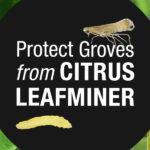Root Out Pathogens
Sample soil for Phytophthora root rot before tree health and yield potential deteriorate.

Many tree nut and citrus growers recently watched their margins erode due to increasing input costs, questionable water availability and lackluster crop prices. Phytophthora root rot, which can reduce tree efficiency and yield potential, puts further pressure on their bottom lines.
“Here in California, growers are running on razor-thin profits,” says Garrett Gilcrease, Syngenta agronomy service representative based in Hanford, California. “Even a minor Phytophthora infestation can cost thousands of dollars a year.”
In Florida, citrus producers face added challenges from Diaprepes root weevils and Huanglongbing (HLB), or citrus greening, both of which damage tree roots.
“When you combine HLB, which can cause major root loss, with Diaprepes root weevil and Phytophthora, it’s a recipe for tree loss,” says Zach Langford, Syngenta sales representative based in Lake Wales, Florida.
Get Ahead of Phytophthora
Gilcrease and Langford say growers can get ahead of Phytophthora root rot with an integrated approach that includes proper irrigation management, resistant rootstocks, soil and root sampling, and fungicide treatments, if warranted.
A water mold, Phytophthora thrives under wet conditions, infecting tree roots and reducing their ability to pull water and nutrients from the soil.
Gilcrease says the pathogen was common when California orchards were flood irrigated. It waned as growers converted to pressurized irrigation systems and began planting on berms. But Phytophthora root rot resurged recently because drip and micro-sprinklers only wet the top foot or so of the soil surface, he says, noting that the key to preventing the disease is proper irrigation management. This includes not overwatering, especially in the spring before trees have fully leafed out and use less water. Growers also should avoid soil compaction and use practices that aid water infiltration.
Even a minor Phytophthora infestation can cost thousands of dollars a year.
As a soilborne pathogen, Phytophthora may infest nut and citrus tree roots years before above-ground symptoms appear. Tree health declines as the infection progresses, causing reduced fruit set, poor vegetative growth, early leaf drop and even tree death.
Take Advantage of Free Soil Programs
Langford and Gilcrease recommend scouting and soil sampling to catch issues early. Syngenta offers a Soil Pathogen Assessment (SPA) program to gauge Phytophthora propagules in California and Arizona orchards. In Florida, Syngenta provides the similar Citrus Soil Assay program.
Charlie McKee, a Florida-based citrus producer in Lake Wales and production manager with Donley & Myers Grove Caretaking, says he has used the Citrus Soil Assay program for 10 to 15 years. It provides information on his own groves and gives him statewide data about citrus tree health.
“It helps you see what’s going on with the root mass and propagules, so you can get the best timing for treatment,” says McKee. “It helps maximize your dollar as much as possible.”
In California and Arizona, Gilcrease says the SPA program began about 10 years ago for citrus growers. It has since expanded into tree nuts. Each year, Syngenta representatives in the two states collect about 1,200 samples for testing. They initially collected only soil samples, which were assayed for Phytophthora propagules ― a type of vegetative reproductive body. If a Phytophthora species wasn’t active at the time of sampling however, lab soil tests often didn’t detect them. Gilcrease says Syngenta representatives now collect soil as well as root samples. As part of pathogen assessment, the laboratory runs ELISA (Enzyme Linked Immunosorbent Assay) tests on roots to detect a protein unique to Phytophthora.
Langford says he also looks at the disease load metric, which is a treatment threshold based on the number of propagules found in the soil, when making treatment recommendations.
“This metric adds another layer of information to help make the best recommendation,” Langford says.
Develop a Resistance Management Program
When lab results warrant a fungicide treatment, Gilcrease and Langford say growers have a handful of options they can rotate for resistance management. Phosphorous acid is a Group 33 fungicide also widely used as a fertilizer. According to University of California – Riverside (UCR) studies, several Phytophthora species have developed resistance or reduced sensitivity as a result.
Ridomil Gold® SL fungicide, a Group 4 soil-applied fungicide from Syngenta, protects trees from soilborne oomycete diseases, including Phytophthora root rot. It is injected through micro-sprinkler or drip systems.
Ridomil Gold GR fungicide is a soil-incorporated granular formulation. The active ingredient in both Ridomil Gold GR and Ridomil Gold SL products ― mefenoxam ― builds up around roots stopping current and preventing future infections.
And Orondis® fungicide — a Group 49 soil-applied fungicide also from Syngenta — controls 11 Phytophthora species, according to UCR trials*. Injected through micro-sprinkler or drip systems and using oxathiapiprolin as its active ingredient, Orondis reduces soil propagules and moves systemically within the tree to improve tree vigor and health.
For more information about the Soil Pathogen Assessment or Citrus Soil Assay programs, contact your local Syngenta representative.
*https://rd.almondboard.com/files/2019%20%20PATH15%20AdaskavegBrowne-Disease%202.pdf
3 Min Read
- Phytophthora can further squeeze razor-thin margins on tree nut and citrus farms.
- Root infestations damage tree health and yield before above-ground symptoms appear.
- Early treatment is efficacious, minimizes cost and increases profit opportunity.























